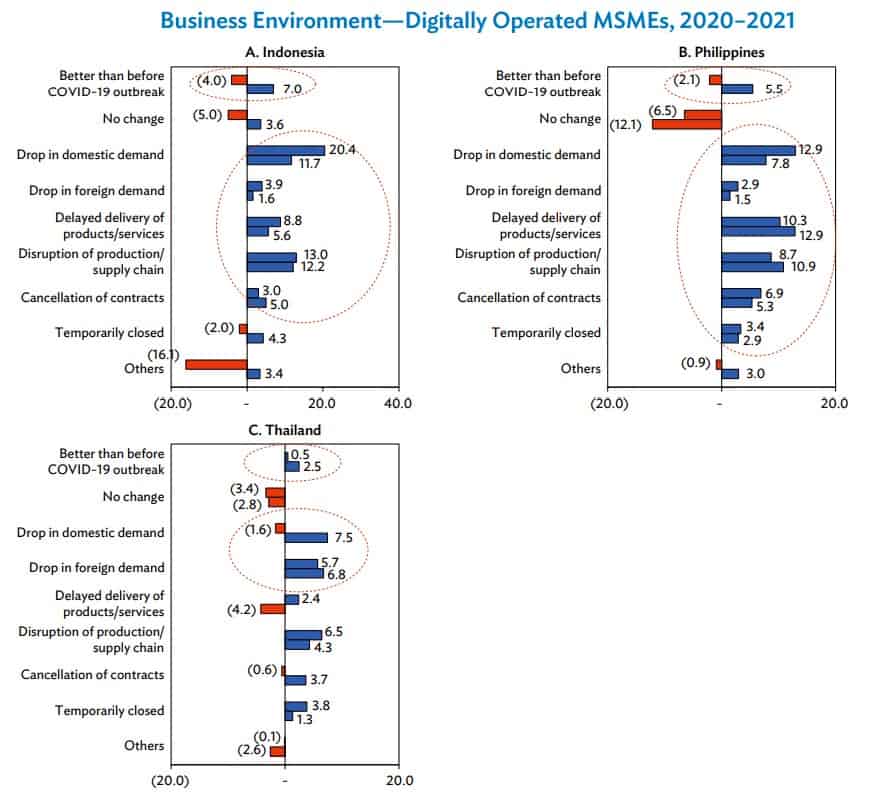Micro, small, and medium enterprises (MSMEs) contributions to the economy and exports have steadily increased over the last few years due to technological advances, government policies, and increasing levels of entrepreneurship across Asia-Pacific (APAC).
MSME contribution by the numbers
MSMEs contribute an impressive amount ($15 trillion in 2021) to APAC’s gross domestic product (GDP), and about 20% to 30% of this contribution goes to the manufacturing GDP.
In the Association of Southeast Asian Nations (ASEAN), Indonesian MSMEs contribute the largest percentage (61%) to their country’s GDP.
In South Asia, India’s MSMEs have one of the highest shares (49% in 2020) in exports. The number of MSMEs in the region, according to the World Bank, is about 170 million.
They outnumber large enterprises and, therefore, employ a significant portion of their countries’ working population. In APAC, exports from MSMEs accounted for approximately $896 billion in 2020.
MSMEs benefit from smart, connected commerce
MSMEs contribute significantly to the exports of APAC countries, ranging from 15% to 49% of the total exports. As commerce became smarter and more connected, MSMEs turned to electronic commerce (eCommerce) to access a more extensive network and a larger regional and international consumer base.

(firms engaged in online selling or e-commerce) and non-digital MSMEs. Blue bars are the percentage points (survey response ratio) higher in digitally operated
MSMEs than non-digital MSMEs. Red bars reflect the opposite. For Indonesia, there were 128 valid samples in August–September 2020 and 2,509 in March–
April 2021; For the Philippines, 686 valid samples in August–September 2020 and 1,546 in March–April 2021; For Thailand, 520 valid samples in August–
September 2020 and 963 in March–April 2021.
Source: Calculated based on MSME surveys in Indonesia, the Philippines, and Thailand, August–September 2020 and March–April 2021.
MSMEs significantly contribute to their GDP, making them a driving force behind developing APAC markets. Countries incentivize and support MSMEs to solidify and expand their businesses within and beyond the region, and MSMEs in APAC with the need to access international markets challenged their expansion.
With the COVID-19 pandemic changing market dynamics, however, the upsurge of eCommerce resolved the issue. MSME businesses require digitalization as they grow rapidly.

“MSME suppliers experienced an increase in customer base locally and internationally during the pandemic due to the boom in eCommerce and mobile commerce, noted Janesh Janardhanan, practice area leader – advisory, supply chain & logistics, Asia Pacific, Frost & Sullivan.
“MSMEs in APAC will increase focus on export opportunities and trade barriers will diminish among countries to create high intra-regional trade growth as regional integration stems from free trade agreements (FTAs).”
Janesh Janardhanan
“Adoption of technological trends boosted last-mile operations and created new customer expectations,” explained
To benefit smarter connected commerce and thrive in this market, MSMEs must:
Adopt digital tools to expand their customer base into international markets and provide digitally advanced services to gain and maintain a customer base.
Partner with strong logistics companies for seamless logistics operations, resulting in greater customer satisfaction. The partnerships also minimize risks and challenges associated with potential supply chain disruptions, enabling business continuity.
Adopt smart business logistic solutions as eCommerce expands and the number of parcels rises.
Leverage technologies, such as Big Data, AI, and the Internet of Things (IoT), to predict any supply chain disruptions and take actions to eradicate them for a smoother logistics experience.
Adopt a technology-driven approach to logistics based on route optimization and delivery automation to enable efficient and quick dispatch and delivery times to meet customer expectations and improve customer experience.
Implement paperless digital trade solutions and customs clearance solutions to improve logistics efficiency and competitiveness of MSMEs, enabling cross-border trade.
“Digital platforms will help MSMEs recover and increase their business in the post-COVID-19 era. With the shift in consumer behaviour and a sharp rise in online shopping, cross-border purchases will gain prominence between 2022 and 2025,” said Salil Chari, Senior vice president of marketing & customer experience, FedEx Express AMEA (Asia Pacific, Middle East, and Africa).

“Smarter, more connected logistics services—such as FedEx International Connect Plus Services (FICP)—will help address cross-border logistics challenges, including more flexibility and control over the delivery process, and navigating diverse shipping regulations and customs in different countries, to improve customer experience and support business growth.”
Salil Chari
“Through solutions like FICP, FedEx helps facilitate and nourish cross-border trade so MSMEs can expand their reach at a greater value,” he continued.
New tools of the old trade
Digital tools improve the efficiency of logistics operations to help MSMEs gain a competitive advantage, with optimized efficiency, productivity, and flexibility to their customers through smart connected commerce. FedEx customizes the location and timeline of deliveries to extend delivery flexibility to customers, supporting the development of MSMEs. Some benefits of smarter digitalized logistics solutions include:
- Improved efficiency and reduced costs associated with administrative delays, such as customs clearance and cross-border movement of freight, enabling timely delivery of goods and no cross-border delays.
- Quick and more accurate monitoring and prediction of logistics delays in real-time, enabling MSMEs to take suitable actions to manage risks. This prevents delays that can lead to customers cancelling orders.
- More efficient last-mile operations, making failures and mistakes negligible and preventing business loss.
- Greater trust and long-term customer relationships for MSMEs due to the ability to track and trace goods via sensors.



